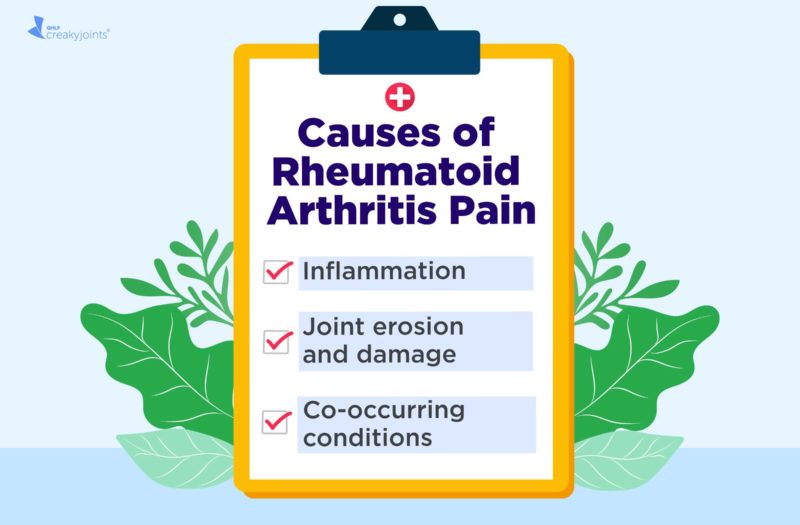Tracking your RA pain can help you better understand your condition and talk about it with your doctor. Join ArthritisPower, a patient-centered research registry, to learn more about your RA. Sign up here.
Pain is the most common symptom of rheumatoid arthritis (RA), a chronic, inflammatory autoimmune disorder in which the body’s own immune system attacks the lining of the membranes that surround the joints (the synovium).
Pain is one of the main reasons that RA patients seek care from a rheumatologist in the first place and seek follow-up visits.
Yet living with RA doesn’t have to mean living with pain forever. “The goal of rheumatoid arthritis treatment is to live a full, asymptomatic life,” says Elizabeth Schulman, MD, a rheumatologist at Hospital for Special Surgery in New York City.
Here is what rheumatology experts want patients to know about RA pain, including:
- Causes of pain
- How to recognize, monitor, and discuss pain with your provider
- Which medications help RA-related inflammation so you can try to resume a flare-free and pain-free life
What Causes Pain in Rheumatoid Arthritis?
When you have rheumatoid arthritis, your immune system, which is supposed to protect against germs and foreign invaders, turns against the body and starts attacking the joints — “and that hurts,” says rheumatologist Angus Worthing, MD, a clinical assistant professor of medicine at Georgetown University Medical Center in Washington, D.C.
Inflammation
“Inflammation is the root cause of RA pain,” says Dr. Schulman. “The joint lining can get inflamed, thickened, and irritated, which causes pain, swelling, and stiffness in the joints.”
Joint Erosion and Damage
RA pain can also be caused by joint erosion and damage. If you delay treatment, or your medication isn’t working well enough, and RA inflammation persists, it can cause permanent damage to the joints, explains Dr. Worthing.
“Once a joint is damaged, even if the inflammation is controlled, it’s uncommon for that damage to repair and the pain might persist long-term,” he adds.
Co-occurring Conditions
If RA patients have low levels of inflammation and few swollen joints but are still experiencing pain, this could indicate the presence of co-occurring conditions that can be common among RA patients, such as fibromyalgia or osteoarthritis. Mental health conditions like depression and anxiety may also play a role, says Dr. Schulman.
“It’s important to remember that once you are diagnosed with RA, not all of your pain will necessarily be from rheumatoid arthritis,” says Dr. Worthing. “A rheumatologist’s job is to figure out if your pain is inflammatory [triggered by the immune system] or mechanical [triggered by movements of the body].”
Examples of mechanical pain that can affect those with RA include low back pain, carpal tunnel syndrome, muscle strains or sprains, tendinitis, and bursitis. “These things can happen to people with RA, but they aren’t necessarily caused by rheumatoid arthritis,” says Dr. Worthing.
Some signs that indicate inflammatory pain instead of mechanical pain in rheumatoid arthritis include:
- Does your pain mostly affect the small joints, like fingers and toes?
- Is your stiffness, swelling, and pain worse with rest?
- Does your pain or stiffness last more than 30 minutes in the morning?
- Does your pain improve once you get moving?
- Does the area in pain look swollen or red, or feel warm?
- Is the pain happening in multiple joints, or is the pain symmetrical (the same on both sides), without the possibility of an overuse injury)?
Read more here about causes of RA pain aside from inflammation.
RA Pain vs. RA Flare: What’s the Difference?
Everyday rheumatoid arthritis pain is different than the pain you feel during an RA flare. According to Vinicius Domingues, MD, a rheumatologist in Daytona Beach, Florida, RA pain is a “constant, nagging pain that is typically worse in the morning,” while an RA flare is a “severe sudden onset of diffuse widespread pain that, if not treated, can put you in bed the whole day.”
“RA pain is a symptom of an RA flare,” says Dr. Schulman. “RA pain would be part of the evaluation that a rheumatologist would do to determine if a patient is having a flare.”
In addition to joint pain, an RA flare can cause fatigue, irritability, aggressiveness, and depression.
Both RA pain and an RA flare can vary in intensity, duration, and frequency, but an RA flare can be alleviated if treated promptly and properly. “Often a short course of steroids can be enough to stop the flare, and then you go back to a cycle of maintenance,” says Dr. Domingues.
It’s not uncommon for an RA patient who is on medication and in low disease activity or remission to have one or two RA flares per year, he continues.
However, if you find yourself getting flares that don’t resolve or come back often, this may mean that your medications are no longer working as well as they should, says Dr. Schulman. This may mean it is time to discuss a medication change with your doctor.
It’s important to recognize and avoid RA flare triggers, which include:
- Overexertion
- Stress
- Hormonal changes (such as the menstrual cycle or entering menopause)
- Infections
- Poor sleep
Alert your rheumatologist if you start to experience more frequent or more intense flares.
Monitoring and Discussing Rheumatoid Arthritis Pain
Pain is pretty subjective and variable, says Dr. Schulman. How people perceive and tolerate pain may differ a lot from person to person.
“Some patients with little joint tenderness [another word for pain] may experience a lot of pain, and some people with really bad inflammatory arthritis don’t experience any pain,” she notes.
This is why it’s important to monitor your pain and be open with your rheumatologist about the level of your pain, your personal threshold for pain, and whether the pain seems new or different from your past RA pain. “Pain is very tricky for everyone involved,” says Dr. Domingues. “There is no lab test for pain, so we really need to have a good honest doctor-patient relationship to gauge pain.”
Tracking your RA pain can help you better understand your condition. Join ArthritisPower, a patient-centered research registry, to learn more about tracking your RA. Sign up here.
Having an open dialogue with your doctor can help them identify the causes of your pain — whether RA inflammation or a co-occurring condition is the likely culprit — and come up with a treatment plan. “Treatment is very different for fibromyalgia than for rheumatoid arthritis than for osteoarthritis,” notes Dr. Domingues.
What specifically does your rheumatologist want to know about your pain?
“If it hurts, speak up and have a conversation with your rheumatologist,” says Dr. Worthing. “I like when my patients tell me which joints are hurting, how long the pain bothers them in the morning, and what types of activities RA pain prevents them from doing. This communication is particularly important in telemedicine because we can’t physically press on the joints.”
Read more here about discussing RA pain during telehealth visits.
Keeping a pain diary can help you clearly communicate the details of your pain to your rheumatologist. Here are some questions to consider when monitoring your pain prior to your next visit — whether in-person or telehealth:
- Where is my pain?
- What does my pain feel like?
- How severe is my pain, on a scale of 0 to 10?
- Is this pain similar to or different from my previous RA pain?
- When did my pain start?
- What was I doing when my pain hit?
- Is the pain consistent?
- How long has my pain been occurring: for days, weeks, or months?
- Is the pain preventing me from doing my job, caring for my family, or taking care of daily living activities?
- How long does my pain last?
- Does my pain improve once I start moving?
- What makes my pain better?
- What makes my pain worse?
- Is my pain preventing me from sleeping?
- How has my pain impacted my emotional state?
- Has anything changed in my life since my pain started (increased stress, diet changes, more or less physical activity, sleep habits)?
- Am I taking any new medication that could interact with my current treatments?
How Rheumatoid Arthritis Medications Treat Pain
Decades ago, pain was part and parcel for people living with RA, but thanks to advances in treatment, a growing number of treatment options, and a “treat-to-target” approach among rheumatologists, living relatively pain-free is a real possibility for many people with RA.
“Treat to target” means picking a disease management goal (like low disease activity or remission) and working closely with your health care provider to tweak your treatment plan as needed to meet that target.
A goal of RA treatment is for you to achieve a state of complete remission from RA, which means no stiffness, swelling, or systemic inflammation — and little to no pain, says Dr. Schulman. “Yet even if remission isn’t possible for you, you can still work with your doctor to achieve low disease activity and fewer bouts of pain,” she says.
RA medications fall into two general categories:
- Drugs that work to reduce inflammation overall
- Drugs that tamp down your overactive immune system to help prevent joint damage and lower your risk of joint disability
These medications work together to suppress the immune system, ease inflammation, stop the progression of RA, and alleviate pain.
You can’t treat RA pain effectively without first controlling the underlying inflammation and stopping the progression of the disease, says Dr. Schulman.
Here is a quick overview of the RA medications that your rheumatologist might prescribe to help treat your RA and minimize pain:
Non-steroidal anti-inflammatory (NSAIDs) like ibuprofen (Motrin, Advil) and naproxen sodium (Aleve) help to quickly relieve pain and inflammation. They are often used in combination with other medications. “They are typically used early on in disease to manage mild symptoms or for breakthrough pain symptoms during a patient’s disease,” says Dr. Schulman. “They do not help prevent the progression of joint disease or damage.”
Glucocorticoids, also called corticosteroids or steroids, help to quickly reduce inflammation. They can help you control pain and swelling until disease-modifying medications “kick in.” They can also be used if you have a flare and need quick pain relief. However, glucocorticoids are not recommended for long-term use because they can have a wide range of side effects. The goal is taper the dose as quickly as possible to prevent long-term side effects, says Dr. Schulman. The most commonly prescribed glucocorticoids are prednisone and methylprednisolone (Medrol).
DMARDs, which stands for disease-modifying antirheumatic drugs, are the most widely used drugs used to slow down the progression of RA. The most commonly used DMARD for RA is methotrexate, which has two benefits: It can block the RA inflammation and also block the body from becoming immune to a biologic drug by preventing the production of anti-drug antibodies, says Dr. Worthing.
Other DMARDs used for RA include hydroxychloroquine (Plaquenil), leflunomide (Arava), and leflunomide (Arava).
TNFi biologics target tumor necrosis factor proteins (TNF) that send signals to your body, leading to inflammation. By stopping TNF, these medications can reduce inflammation and pain. They may be added to a DMARD or used alone without a DMARD. TNFi biologics include adalimumab (Humira), certolizumab pegol (Cimzia), etanercept (Enbrel), golimumab (Simponi, Simponi Aria), and infliximab (Remicade).
Non-TNFi biologics interact with different parts of your immune system and block chemicals called cytokines that cause inflammation. Non-TNFi biologics may be added to a DMARD or used alone without a DMARD. For RA, these medications include abatacept (Orencia), anakinra (Kineret), rituximab (Rituxan), sarilumab (Kevzara), and tocilizumab (Actemra).
Janus kinase (JAK) inhibitors decrease your immune system’s ability to make certain enzymes that can lead to RA symptoms, including pain. JAK inhibitors may be added to a DMARD or used alone without a DMARD. Common JAK inhibitors include baricitinib (Olumiant), tofacitinib (Xeljanz), and upadacitinib (Rinvoq).
When It’s Time for an RA Treatment Change
Even if your rheumatoid arthritis has been under good control for years, your medication can stop working after years of being on it, says Dr Schulman.
Luckily, there are many treatment options now and each works differently (this is known as mechanism of action). If one type of medication is no longer providing adequate relief, a medication with a different mechanism of action may be a better fit for you.
Read more about when to consider an RA treatment change.
If you think there’s a link between your medication and increased RA pain, you might want to ask your rheumatologist the following:
- Is it possible that my medication has stopped working?
- Are there any other medications we should try?
- Are there any different medication combinations we should try?
- If we change medications, how long might it take for me to see results?
- What do I do if my symptoms come back?
- Are there any alternative or complementary treatment options that could help with pain?
The bottom line: Addressing pain with your rheumatologist is essential for feeling your best and living a full life. With so many rheumatoid arthritis treatment options available, there is no reason to settle for feeling only “fine” instead of “great.”
Keep Reading
- 6 Causes of Rheumatoid Arthritis Pain Aside from Inflammation
- How to Discuss Your Rheumatoid Arthritis Pain During a Telehealth Visit
- Rheumatoid Arthritis Pain: 7 Things You Should Tell Your Rheumatologist
- Rheumatoid Arthritis Pain: When to Consider a Medication Change
Track Your RA Pain with ArthritisPower
ArthritisPower is a patient-centered research registry for joint, bone, and inflammatory skin conditions like rheumatoid arthritis. You can select different health assessments that matter to you, and choose how often you want to take them. When you have an upcoming doctor appointment, you can discuss your latest assessments and feel more informed. Learn more and sign up here.
This article is part of A Patient’s Guide to Understanding Rheumatoid Arthritis Pain and was made possible by a grant from Sanofi Genzyme.
Boyden SD, et al. Non-inflammatory Causes of Pain in Patients with Rheumatoid Arthritis. Current Rheumatology Reports. April 2016. doi: https://doi.org/10.1007/s11926-016-0581-0.
Interview with Angus Worthing, MD, rheumatologist and clinical assistant professor of medicine at Georgetown University Medical Center in Washington, D.C.
Interview with Elizabeth Schulman, MD, rheumatologist at Hospital for Special Surgery in New York City
Interview with Vinicius Domingues, MD, a rheumatologist in Daytona Beach, Florida
Kuijper TM, et al. Flare Rate in Patients with Rheumatoid Arthritis in Low Disease Activity or Remission When Tapering or Stopping Synthetic or Biologic DMARD: A Systematic Review. The Journal of Rheumatology. November 2015. doi: https://doi.org/10.3899/jrheum.141520.
Lee YC, et al. Pain in Rheumatoid Arthritis. The Rheumatologist. October 7, 2011. https://www.the-rheumatologist.org/article/pain-in-rheumatoid-arthritis.






